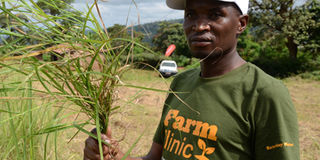Why growing Rhodes grass is a wise choice

Buyi shows how mature Rhodes grass looks like. PHOTP BY GEORGE KATONGOLE.
What you need to know:
- Urbanisation has had a major effect on grass production in Uganda. This has had a major effect on the dairy production chain. However, it is important to find alternatives that can increase efficiency and Rhodes grass, comes in a handy, writes George Katongole
Napier is the most common grass in Uganda but it is constantly facing challenges of diseases. The most outstanding disease is Napier stunt and head smut diseases which causes massive losses.
Yet feeding accounts for the greatest portion of variable costs of producing milk. Challenges of urbanisation and climate change are also limiting forage supply.
While such circumstances can threaten the profitability of the dairy sector, researchers argue that Rhodes grass, also known as Guyana, is a smart option.
Laban Buyi, a livestock technician at Bunginyanya Zonal Agricultural Research and Development Institute (Zardi) in Bulengeni, Bulambuli District, says that farmers have a choice of Rhodes grass.
Case for Rhodes grass
Buyi says, “If you can produce good-quality grass that is what pulls your cattle’s fat and protein up thus keeping the cow well fed.”
Rhodes grass, Buyi says, is an adapted perennial grass that makes excellent hay yet it has a fast maturity rate of three months.
On top of that, Rhodes grass is drought and saline tolerant and can withstand seasonal waterlogging. It is also useful for erosion control by virtue of its spreading growth habit. Up to three crops per year can be produced in most cultivars.
Farmers should also be aware that Rhodes grass is very palatable. Crude protein levels vary with age of regrowth and level of available soil nitrogen, from about 17 per cent in very young leaf, to 3 per cent in old leaves.
Similarly, digestibility may vary from 80 per cent in very young growth to 40 per cent in older growth.
“Rhodes grass can be very helpful to farmers in sustainable agriculture development,” Buyi said.
Alternative fodder crops include brachiaria mulato, Congo signal and Guatemala, which is disappearing. Napier, which has good palatability in the early growth stages, has a crude protein content of 7 per cent with Congo signal and brachiaria ranging between 10-13 per cent.
“Smallholder farmers need fodder that can offer more advantages. Providing more productive forages for dry areas may support increased livestock numbers with associated environmental stress,” Buyi explains.
Rhodes grass has been present in Uganda but it is largely unpopular as Napier could grow wildly in many parts of the country, says Buyi.
But Rhodes grass is limited to hay, according to Buyi. “Silage must be harvested from grass with broad leaves like maize, Guatemala and Napier while Rhodes can only be used for hay,” he says.
The advantage with hay is that it makes animals to drink a lot of water because of its dry matter content which increases the milk and butter content.
Seed multiplication
Buyi says that obtaining the right seeds is important but the cheaper option is to multiply the seeds afterwards. “You can make your seeds to be able to get more benefits,” he says.
This is done by harvesting some grass for hay and leaving the other to mature fully. Mature Rhodes grass that must be harvested needs to be tested first. This is done by holding a head of seeds and rub it gently between the palms. Once it is mature, the seeds will drop.
The next step is to cut the heads using sharp objects like a kitchen knife, sickle or panga. The harvested heads are put into a bag ready for drying at the farm.
Drying should be done on polythene sheets or canvas and this process can take up to two days. Thereafter, seeds are threshed to enable the removal of seeds but this must be done by right beating.
The seeds are later sieved to get pure seeds from the stalks using sieve nets. Re-drying to confirm the right moisture content is advisable because deeds are normally harvested at different times and it is important to ensure they are uniformly dried.
The seeds should be bagged in sacks that can allow aeration and then stored in a dry, well ventilated room with moderate temperature.
Agronomy
Buyi explains that seeds are obtained from Naro stations especially Bulengeni, which has a gene bank for drought tolerant genotypes as well as at Namulonge, Nakyesasa and Nabuin Zardi in Nakapiripirit District. Seeds can be grown by drilling or broadcasting but he suggests that the best idea is to plant in lines for better weed management.
The seeds are sprinkled in the dug furrows and covered with a thin layer of soil. “But it is not advisable to cover the seeds during the rainy season as they can rot away,” Buyi explains.
The seeds are better planted during the rainy season to reduce costs of irrigation.
Hand hoe weeding is the better practice but it is advisable to protect the grass from stray animals by fencing or using buffer crops. There are no serious diseases associated with Rhodes grass although the armyworm is a dangerous pest that can attack it.
In infertile soils, it is advisable to apply fertiliser, especially superphosphate or urea. It takes about three months to harvest the grass if it is going to be used for hay.
But Buyi argues that the best time is when the grass is about to start flowering. “Because when plants flower, most of the proteins go into seed formation which leads to poor quality forage.”
Harvested grass can be fed directly to the animals or baled as hay.
Briefly
Rhodes grass (Chloris gayana)
Agronomic recommendations:
Seed rate: 5.5-6.5kg/ha
Spacing: 50cm between lines.
Planting depth: 2cm
Planting method: Drilling or broadcasting
Maturity period: Three months




